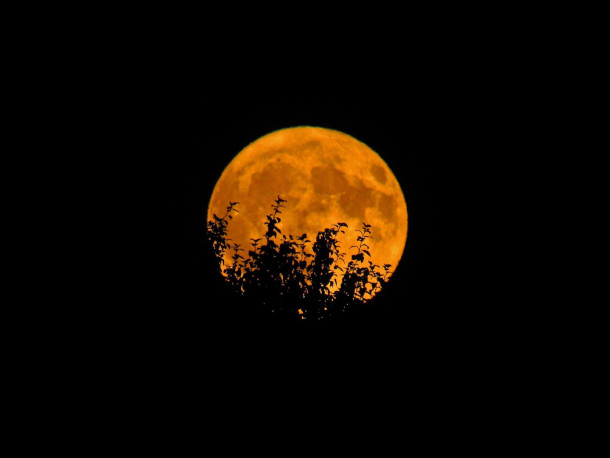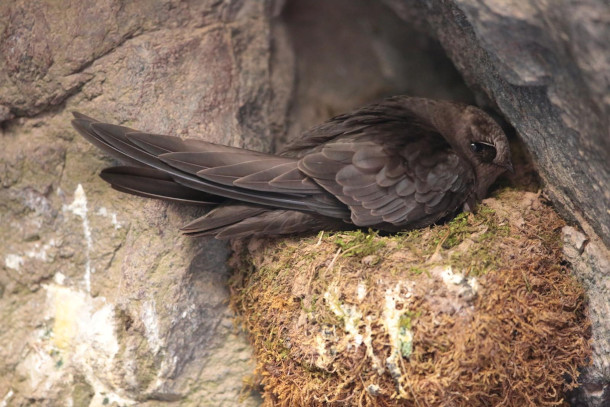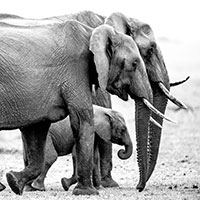BirdNote®: Black Swifts Reach for the Moon
Air Date: Week of October 3, 2025

“Harvest moon” is a colloquial name for the full moons that appear in early autumn in the northern hemisphere. Many animals find their lives affected by the lunar cycles. (Photo: Jeff Hollett, Wikimedia Commons, Public Domain)
There are all sorts of ways that life on Earth takes advantage of the regular cycles of the moon, from horseshoe crabs and grunion fish that lay their eggs during the high tides of a full moon to corals that spawn en masse in the days afterwards. Michael Stein reports for BirdNote® on how black swifts are also synced to lunar cycles and fly higher during the full moon.
Transcript
DOERING: It’s Living on Earth, I’m Jenni Doering.
O’NEILL: And I’m Aynsley O’Neill.
[BIRDNOTE THEME]
O’NEILLL: The full moon on October 6th is known as the “Harvest Moon”, and it’s also the first supermoon of 2025, which is what we call it when the moon is relatively close to Earth and it appears a little bigger and a little brighter. There are all sorts of ways that life on Earth takes advantage of the regular cycles of the moon. The full moon triggers mass coral spawning within a few days, and many other creatures including horseshoe crabs and grunion fish lay their eggs during the resulting high tides. And there seems to be one bird species in particular that has a close connection with lunar cycles. Michael Stein has this BirdNote.
BirdNote®
Black Swifts Reach for the Moon
Written by Conor Gearin
[Whistling wind]
[Black Swift flock calls]
Black Swifts are extraordinary birds. They spend most of their lives in the air and migrate thousands of miles every year. But researchers have found that their lifestyle is even stranger than we once knew.
[Black Swift calls]
Scientists placed lightweight tracking devices on swifts nesting in Colorado. This let them study their movements once they reached their wintering grounds in Brazil. This provided unprecedented access to the swift's world in the skies. Astonishingly, Black Swifts spent over 99% of their time in the air during the winter, almost never touching the ground for months.
What’s more, the swifts flew to incredible heights, reaching the highest altitudes on nights when the moon was full – sometimes over 13,000 feet! It’s the first time scientists have seen birds changing their altitude along with the cycles of the moon.

A black swift in its nest. (Photo: Aaron Maizlish, Flickr, CC BY-NC 2.0)
[Black Swift calls]
It’s still unknown why the moon seems to draw Black Swifts high into the sky. It’s possible that insects, many of which can also fly thousands of feet in the air, are attracted to the moon, and swifts follow their insect prey upward.
What is clear is that these birds have abilities beyond what our eyes can see.
[Black Swift calls]
I’m Michael Stein.
###
Senior Producer: Mark Bramhill
Producer: Sam Johnson
Managing Editor: Jazzi Johnson
Content Director: Jonese Franklin
Bird sounds provided by The Macaulay Library of Natural Sounds at the Cornell Lab of Ornithology, Ithaca, New York. Black Swift ML 363245171 recorded by Rose Ann Rowlett.
Black Swift Xeno Canto 677210 recorded by Richard E. Webster.
BirdNote’s theme was composed and played by Nancy Rumbel and John Kessler.
© 2023 BirdNote March 2023 / 2025
Narrator: Michael Stein
ID# BLSW-01-2023-03-10 BLSW-01
Reference:
https://www.cell.com/current-biology/fulltext/S0960-9822(22)00397-9
O’NEILL: For pictures and more, follow your excellent instincts to the Living on Earth website, loe.org.
Links
Living on Earth wants to hear from you!
Living on Earth
62 Calef Highway, Suite 212
Lee, NH 03861
Telephone: 617-287-4121
E-mail: comments@loe.org
Newsletter [Click here]
Donate to Living on Earth!
Living on Earth is an independent media program and relies entirely on contributions from listeners and institutions supporting public service. Please donate now to preserve an independent environmental voice.
NewsletterLiving on Earth offers a weekly delivery of the show's rundown to your mailbox. Sign up for our newsletter today!
 Sailors For The Sea: Be the change you want to sea.
Sailors For The Sea: Be the change you want to sea.
 The Grantham Foundation for the Protection of the Environment: Committed to protecting and improving the health of the global environment.
The Grantham Foundation for the Protection of the Environment: Committed to protecting and improving the health of the global environment.
 Contribute to Living on Earth and receive, as our gift to you, an archival print of one of Mark Seth Lender's extraordinary wildlife photographs. Follow the link to see Mark's current collection of photographs.
Contribute to Living on Earth and receive, as our gift to you, an archival print of one of Mark Seth Lender's extraordinary wildlife photographs. Follow the link to see Mark's current collection of photographs.
 Buy a signed copy of Mark Seth Lender's book Smeagull the Seagull & support Living on Earth
Buy a signed copy of Mark Seth Lender's book Smeagull the Seagull & support Living on Earth

